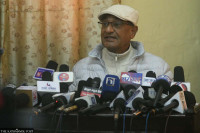National
Jajarkot earthquake raises concerns about poorly built houses
Many local governments have yet to implement the National Building Code to ensure structural safety of buildings.
Prithvi Man Shrestha
Hardly any houses in Barekot Rural Municipality of Jajarkot are intact after Friday’s magnitude 6.4 earthquake, which also killed at least 153 people and injured 364 others in Jajarkot and Rukum West districts.
Barekot has around 4,300 houses, according to the rural municipality. “Of them, some 1,000 have been fully damaged, and 1,500-2,000 are at high risk,” said Bir Bahadur Giri, chairman of the rural municipality. “People here won’t feel safe until they rebuild all the houses as almost all of them have suffered some damages.”
Barekot is among many local governments that are yet to implement the building code. The building code is a minimum standard set by the government for the construction of buildings and is an important tool for mitigating earthquake risk.
“Our village assembly recently endorsed the working procedure to implement the building code,” said Giri. “We will implement the code strictly for new constructions.”
The National Building Code prepared by the federal government has set different standards for building houses for different locations based on seismic data.
Nepal’s Local Government Operation Act-2017 has granted local governments the authority to grant permits for building houses in compliance with the National Building Code as well as regulate and monitor whether the code has been followed.
However, local governments say the code has not been fully implemented across the country. “Due to lack of awareness of the building code and economic hardship, it is difficult to implement the code in a rural municipality like ours,” said Giri. “Many people believe that it will be expensive to build a house by following the code,” he said.
Building code in Nepal was first introduced in 1994. But the importance of its effective implementation was widely felt only when the country suffered a major earthquake in April 2015.
In 2015, a magnitude 7.8 quake killed nearly 9,000 people in Nepal while damaging nearly 800,000 houses, according to the Post Disaster Needs Assessment Report 2015.
Likewise, 920 heritage sites, 402 monasteries, 7,553 schools, 1,197 health institutions, 415 government buildings, 216 buildings of security agencies and 672km of road in different districts were damaged.
With the Indian subcontinent creeping toward Eurasia, earthquakes in the country are primed to be potentially more devastating, according to Scientific American.
Even though the country is highly vulnerable to earthquakes, experts say most private buildings and public infrastructure are not good enough to withstand quakes of high magnitudes.
“Particularly, old infrastructure including old houses are vulnerable as most of them do not meet new construction standards,” said Shyam Sundar Jnavaly, executive director at National Disaster Risk Reduction Centre-Nepal, a non-governmental organisation working in research, evaluation, project implementation, and knowledge management.
The majority of the houses damaged by the latest earthquake are old and traditional houses made of mud and stones, according to officials.
According to the records maintained by the Nepal Emergency Operation Centre under the Ministry of Home Affairs, the latest quake damaged over 26,500 houses fully and over 35,000 partially in Jajarkot, Rukum West, Rukum East, Salyan, Rolpa, Nawalparasi East, Dailekh, Baitadi, Jumla, Kalikot and Pyuthan districts, as of Wednesday afternoon.
In Bheri Municipality of Jajarkot, 3,278 houses were fully damaged while 5,073 were partially damaged, according to the municipality’s record. “Majority of the damaged houses were built with mud and stone. One of the buildings that suffered damage in the earthquake is the Jajarkot Palace which we wanted to preserve,” said Mayor Chandra Prakash Gharti.
King Gajendra Narayan Shah of Jajarkot is said to have built the palace in 1343. The seven-storey palace was reduced to four storeys by the massive earthquake of 1934.
“Hardly any RCC [reinforced cement concrete] type building suffered significant damage except for a few of them getting cracked walls,” said Gharti.
According to him, his municipality has implemented the building code for new houses, but old houses built without following the code were badly damaged by the latest quake.
Experts say efforts should also be made to retrofit old buildings to enable them to withstand quakes to some extent. “The government can encourage people to upgrade their existing houses by providing a certain grant, in addition to the grants provided to quake victims for building new houses,” said Jnavaly. “People living in old houses are naturally more vulnerable to earthquakes.”
According to the latest Population and Housing Census 2021, there are a total of 7,552,066 building structures in Nepal including both private houses and public ones.
There are a total of 6,660,841 households of which 2,042,978 housing units are made of mud-bonded bricks and stones and 3,474,957 of cement-bonded bricks and stones.
As per the earlier census of 2011, most families (41.38 percent) lived in houses with their outer wall made of mud-bonded bricks or stone, followed those living in houses with outer wall made of cement-bonded bricks or stone (28.74 percent), of bamboo wall (20.23 percent), and of wood/planks (5.31 percent).
This suggests the number of houses made of cement-bonded bricks or stones is growing. “The building code has fixed a certain standard for houses to be built with mud-bonded bricks or stones,” said Jnavaly. “That should be implemented properly wherever such houses are built.”
Houses in western Nepal were damaged by the latest jolt as the majority of them were structures built without following the building code, according to local governments concerned.
But even eight years after the mega earthquakes of 2015, building code has not been implemented even in the districts that were hardest hit by the quakes.
A study conducted by the Housing Recovery and Reconstruction Platform, a non-governmental organisation, revealed that many municipalities in the districts affected by the 2015 earthquakes have failed to implement the building code. The study was conducted in 2021 with funding from the United Kingdom.
For the quantitative survey, 34 municipalities from 24 districts listed among the most-affected to least-affected were selected. The sample size spanned over 18 rural municipalities and 16 urban municipalities.
“Only 20 municipalities [approximately 59 percent] among the surveyed have implemented the building code, but among these, a majority of the municipalities focused on semi-urban and urban areas only,” the study report says.




 13.12°C Kathmandu
13.12°C Kathmandu













%20(1).jpg&w=300&height=200)

